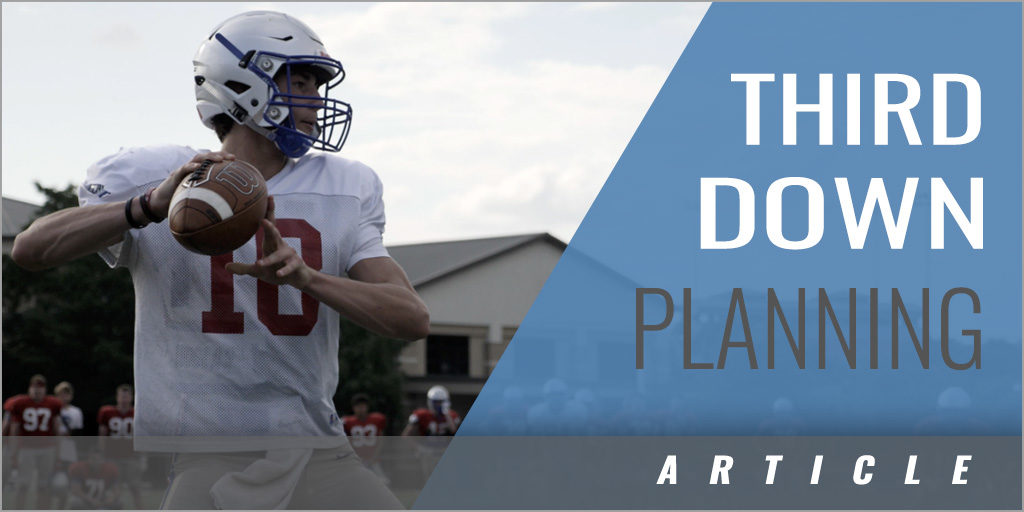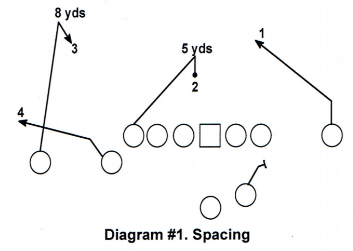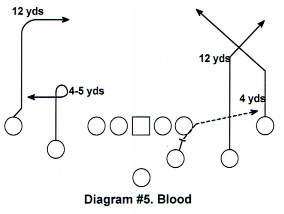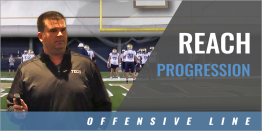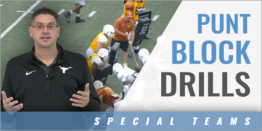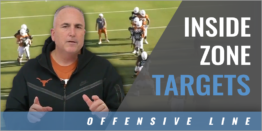|
By: Bryan Harsin - Boise State University Originally Published in: 2018 Nike Coach of the Year Clinic Manual - Earl Browning Provided by: Nike Coach of the Year Thank you for that introduction. I will get into more of my background in a minute, but first I want to show you a video. We do this a lot at Boise State. It kind of gets us cranking. It may not be a highlight video. We use a lot of motivational video. I hope it works. This is something to get us started. The bottom line is you are here to get better. I appreciate you being here. This clinic has been three days with some great speakers. Kirby Smart was here and did an outstanding job. I spent some time with him a couple of weeks ago and I really enjoyed myself. It was awesome. They played in the national championship game and I know you guys who heard him know why. He is a very bright defensive mind. He is a fantastic coach. I am from Boise. I was born and raised there. I went to Capitol High School. The quarterback who played before me was Jake Plummer. They called him "Jake the Snake." They called me the "mongoose" and that did not compare what so ever. He had a big beautiful poster and I had a hand drawn picture that looked like a third grader. I knew where I stood. I walked on at Boise State in 1996. Pokey Allen was the head coach but passed away a short time after that. Tom Mason became the interim head coach. After that was Houston Nutt. He came from Murray State in Kentucky to Boise, Idaho. He stayed here 8 months and 2 days, left and went to Arkansas. He was followed by Dirk Koetter, who is at Tampa Bay now. My quarterback coach was Mark Helfrich, who became the Oregon head coach. I had some really good coaches around me. My dad was a mechanic. I was around a lot of car races. I raced cars and really enjoyed it. I happened to work a Capitol football camp. I worked with the quarterbacks. I met a couple of high school coaches there who thought I did a good job and I should give some thought to coaching. That kind of clicked and I thought it was something that I might do. At Boise State, I was a backup quarterback not playing and sitting on the sidelines watching the demeanor of coaches signaling plays. I decided that was what I wanted to do. I sent 50 resumes out and I got three responses back with "no" as the answer. I finally hooked on at Eastern Oregon. We were a no-huddle triple option team with the slowest quarterback in America. We won a few games but I learned a lot. I got the chance to come back to Boise when Dan Hawkins got the job. After a year I got a permanent position as tight ends coach. At that time Chris Petersen was the offensive coordinator. When he became head coach, I was the offensive coordinator until 2010. I went to Texas with Mack Brown for two seasons. That was a fantastic two years. I took the head job at Arkansas State and went back to Boise when Coach Petersen took the Washington job. I was fortunate to be around fantastic people. I sat back and watched them do it and I learned from it. I appreciate you guys being here. We are going to talk a bit about third down and the planning that goes with it. Our players have just come through the off-season and they look really good. Their body fat is down, they are stronger, and are raring to go for spring practice. Our speed and lifts are up and now we have to apply that to the game field. For the coaching staff we want to try to keep it simple. What is simple gets executed and what is complex gives people an excuse. I am not talking about simple schematically, I am talking about simple for your players. To teach that takes time. That means sitting in meetings like this and taking one or two nuggets out of the lecture. At the end of the day that is the important thing. We want to be improving as a team. We want our players to improve, but how do we get better as coaches? The coach is the one teaching the player. You have to be clear and concise so he knows exactly what to do when he walks out of that meeting. That allows him to go play fast and do the things you are asking him to do. We have just come back from visiting in some professional development at another program. We went into the meeting like an eighth grader and told them to "coach us up." The quarterback coach got fired up and started at the beginning with the stance and hand placement under the center. He gave us the whole treatment. That matters to us because we want to know we are doing it the right way. Here is an outline of what I am going to try to get over today.
People are going to judge you as to what you do on game day, but that is fun to me. That is why we put in the hard work. We hope we win the game, but we want to have fun and make some highlight films. You hope your players want to do that. You have to convince them that they have to do the work to get there. You have to go back and do that each and every week. We want to improve daily. You cannot put it on autopilot and hope we are ready on Saturday. You have to teach and focus on that every single day. Here is our goal and what we talk about. It has not changed for a long time.
Class, integrity, and academic excellence means certain things to us. If we can accomplish this with our players, they will get rings, a graduation diploma, they will learn how to treat people, and do things right. What an experience we can give our players while they are here. People all the time are talking about the culture of a team. Whatever actually happens is what your culture is. Practice Expectations: We have 1 speed when we play and that is
Practice expectations matters. These are the things we talk to the team about on Sunday before we step on the practice field on Monday. We are in attack mode for 4-6 seconds. We are going to watch tape of practice and if the player is not in attack mode, that is a loaf. We talk about reps in practice, but how about reps in life. How about rep in your culture and teaching habits. When we talk about reps do it on your life. Gets reps in marriage, in class, get reps on the important things. If we can ask that of our players, why can we not do it ourselves? If we are supposed to be in full gear, that is what we want. I will check to make sure they do it. We never walk on the practice field. We run from drill to drill. We run from the stretch period at the beginning of practice to the last reps of the last drill. If they walk, we go back and do it all over. That is a mindset and you create that with your team. Practice Expectations (continued)
On the field is a physical classroom. It is all teaching until we go play. You are learning throughout the game. It is a physical classroom and you need to pay attention to what is going on. This is one of the things that drives me crazy. We need to get ready for practice with a sense of urgency. I have had players that come strolling out to practice one minute before we start. They are your players and that sends a bad message to everyone on that team. I know this, when we go out to practice, we are playing the Broncos every day. We are competing against ourselves. Our teammates have to help us through competition. During our special teams periods, we do not have coaches on the sidelines with their arms folded, horsing around. During the stretch period we do not have coaches standing around watching things happen. I want them to get involved. This is the time to get around and talk to and meet the players. That is when you start to build relationships. There are so many chances in a 2 hour window for you to get better. However, you must maximize the effort and have the discipline to do it. Practice Expectations (continued)
There is never an excuse for a pissed off linebacker to lay out a wide receiver because he is mad at his coach. That is not going to happen at Boise State. We do not want offensive linemen to cut anyone who is not ready for it. That is my job to protect the players at practice. If they go hard, I have their back. But they must go hard. If you do not practice you do not play. At the end of practice and someone is speaking, do not start taking off tape or some other distracting thing. The coach has two minutes at the end of practice to address the team. Listen to what he is saying and do not distract in any way. Do not talk among yourselves. The worst thing is to have the coaches standing in the back talking. Practice Expectations (continued)
When you just got your butt chewed out, you need to reflect on that in the locker room. You need to take five minutes and think about what went on in practice. If you are honest you will tell yourself, you have got to get better. After that five minutes you will come to the conclusion that you do not want that to happen again. This is the same message I gave our team last year and we went on to win the Mountain West Championship. This is how we practice. We are going through it every day and teach from it every day. We film the practice and show them the effort it takes to win. We want extreme effort on every play. If we intercept a pass we want to return it for a score. Every game that we have scored on a turnover, we have won. In practice we have players and coaches flying around to make those things happen because it matters. It changes the game. When you watch your film keep your eyes on the backside of the play and watch the effort you get from players who are not involved in the initial part of the play. Watch what they do in their pursuit angles and techniques. I coach those points up in our meeting. When we watch the film we make sure they know what we are expecting from them. That is my job to get them to know what a good practice looks like. You play like you practice. If you practice badly you play bad. When one of our big boys makes a play, we get all fired up about it. They never get to touch the ball and when they do it is a big deal. Let everyone feel the enthusiasm. We had it happen and the team came off the sidelines to congratulate him. This was practice and the reaction was great. You have to show the joy in the process. We want everyone to know what the expectations are about practice and we are not going to assume anything. Third Down
Our goal this year was 48 percent and we actually converted 46 percent of the time. That ended up being 9th in the country. In situational offense, we have goals clearly defined. In short yardage, which is 1-3 yards, we want to be 55 percent. In the 4-6 yards situations, we want to be 50 percent. On long yards, which is 7-10 yards we want to be 40 percent and extra-long, which is 11 and up we want to be 25 percent. We take pride in playing the 3rd down. We called it the money down. In the 3rd situation is where the offense makes their money. Our 4th down percentage was horrible and we are going to work on that this year. The 3rd and 4th are the downs we have to win. This is one of my favorite concepts in the 3" down situation. (Diagram #1) We call it "spacing." We have run this for a long time in a variety of ways. When you read this play, you have to read it in a progression.
The quarterback can jump around and pick out a pattern, but that is not the way to do it. If you do not read the progression the right way the receivers will not open up because your eyes will not be in the place they need to be. We read this play only one way. We start on the single receiver side and we go through a true progression. There are so many defensive secondary calls now, you must do it that way. The offense is going fast and the defense is trying to move. If the quarterback does not have a progression, he will never see the receivers open up. He reads slant, pivot, spot, and flat. If they are all covered, and he is not, he runs the ball. If he is going to the slant, his footwork is catch and throw. If he does not throw that he resets to the pivot over the ball in the middle at six yards. If he does not throw there he resets and throws the 8 yard spot to the backside. Lastly he looks to the flat pattern. We did not run this play enough. If you want to put the defense in a bind, put the formation into the boundary. That makes the nickel lines up to the formation and you get your best receiver working one-on-one with a lot of grass to run into. You want to run this play on 3rd and 4-6 yards for the first down. You can run this play at any place on the field. This is the play that over time is unstoppable. We practice it and it is one of the first plays we install. Everyone has a play they like to go to. I like this play. The play is easy for the quarterback, It is an easy protection scheme. You do not want to put the running back on a monster, because the ball is gone so quickly that his block does not have to be that good. All he has to do is get the defenders hands down. I think this is a must pass in any offense. Teach it, practice how to read it, and then get creative. Run it from different formations and motions. The next concept we call "dodge." It is a progression just like the spacing concept. (Diagram #2) It can be run in a lot of different ways. It is an empty set with a high/low read on the backside. The 5-yard out is lA in the progression. The flag is 1 B. The reason we number them like that is because you do not want to go through five reads. This is kinds of a smash concept. If we can get the boundary out, we will take it every time. Deshaun Watson won a national championship just pitching the ball to the out pattern.
If they give us the easy throw we will take it. If the corner drives on the pattern, we take it over the top to the flag pattern. If the Will linebacker buzzes outside and cuts off the out and the corner settles over the flag, the quarterback goes to his 2nd read. That is the under pattern coming across the field under the linebacker. If the Mike linebacker picks up the under pattern, the quarterback goes to his 3rd read with the 10-12 "in" pattern with the slot receiver. It is simple progression. It is easy for the quarterback and we have a simple five-man protection. There are ways to get six-man protection if you want. This play is like a run-and-shoot play that June Jones used to run at Hawaii. They have confidence in the reads and when they come to the line of scrimmage, they know what they are going to get from the defense. We can use a tight end trips formation with the tight end to the backside of the trips. (Diagram #3) The tight end runs the flag, the back in the backfield runs a flat pattern instead of the five yard quick out. The back side patterns are all the same. The inside slot runs the under, the outside slot runs the in, and the wide receiver run his five yard "in" pattern.
The quarterback's first read comes off the corner. If he bites up on the flat, we throw to the 1B receiver running the flag. If the safety gets over to cover the flag, we go to the 2nd choice coming under the linebackers. If they cover that, he goes to the 12 yard "in" pattern. It is the same play with the same reads. We can throw the pattern into the wide field. However, we tell the quarterback he better love the quick out or flat that way. It is a risky throw. Throwing a sideline cut into the wide field requires a strong arm. We put a heart (you got to love) on this pattern. However, nothing changes with the quarterback's reads. If everything is covered, the quarterback can always run the ball. We do not want to force anything. When we run the quick out we run it at five yards. If we run a flat, that is run at four yards. The flag is a four step inside foot cut. That puts the receiver's foot in the ground at 10 yards. The under is under the linebacker at a depth of 4-5 yards. The "in" pattern is three yards outside the tackle and 10-12 deep. The "run" (dig) route is five yards coming to the inside. The "run" route reads the coverage as he goes. If he has man-coverage, he continues his route to the inside and runs away from the man-coverage. If there is zone coverage, he finds the hole and settles in the hole. The Press-X is another progression pattern. (Diagram #4) When I teach patterns, I am a step coach. I teach the patterns off steps. The press-X is a pass for the 7-10 yard first down. This is a man-beater pattern. The outside receiver to the formation side takes an outside release and tries to get deep. He is the alert pattern for the quarterback. That means he thinks he can beat the corner for the long ball. He is the 1st choice for the quarterback.
The slot receiver runs a three step off his inside foot "out" cut. That puts him in the 10 yard area. If the receiver is shorter, it may take him more steps to get to 10 yards. He is running an out pattern to the sideline unless the corner rolls in cover-2. If that happens, he settles the pattern in the hole. l like steps on timing routes. The inside slot runs a climb route. He goes underneath the Sam linebacker and over the Mike linebacker heading to a depth of 15-16 yards. He is the hot receiver for an inside blitz. As he leaves the line of scrimmage, he looks for the linebacker blitz. If they blitz he looks for the ball immediately. We do not have many hot routes or sight adjust patterns. We have 0-coverage beaters built into the concepts. The under pattern comes across the field at 4-5 yards deep and works to three yards outside the playside tackles alignment. On the backside of the play, the running back runs a check-swing pattern. That is a great outlet pass for the quarterback. This is a man-beater concept. You can run it against zone, but it is designed to run against man-coverage. We are looking for leverage and a man beater. If we get a zone defense we are looking to go to the under pattern. We want to eliminate the outside patterns. Against zone, the outside routes have to be adjusted and we do not want to do that. The under pattern versus man-coverage is haul-ass. The receivers do not read anything. We lean into the defender and run away from him. This play is designed to offset press coverage. The play is designed to hit the pressed alert receiver, the under, or the running back. The last concept is the 11 plus play. This is the extra-long pattern. (Diagram #5) In this concept, we have a blood concept to one side and what we called "whip it inside" to the other side. If we get quarter's coverage, we are going to work the blood side of the concept. Those are the patterns into the field. The slot receiver wants to get nose-to-nose and toes-to-toes with the defender. It is usually a seam runner defender or in quarter coverage it is the safety. He wants to take up all the cushion and get close enough to smell his breath.
He wants to get into the defender and break to the corner. The outside receiver is doing almost the same thing and breaks to the post. The tailback is going to check and run his flat. He may be called on to chip on the defensive end on the way to the flat. He wants to get that pattern to 4 yards deep. This is a flood type of concept. To the boundary we are running the "whip it inside" concept. This side is the cover-2 or man-beater side. The slot receiver runs his pattern off the Will linebacker. He wants to get as tight to the backer as he can, break away from him to the outside, and continue to run his pattern out if it is a man-coverage scheme. If it is zone, he settles between the corner and Will linebacker. The outside receiver runs a four-step on the inside foot, dig route at 12 yards. The quarterback's drop is a quick three-step drop, normal three-step, or a big three-step drop. If we go under the center than we can use a seven-step drop. If the defense shows blitz and they are going to bring more than we can block, the quarterback has to handle that. He has a problem and he must know where his quickest throw is going to be. We can get the ball out quickly, half roll, or sprint out to avoid the rush. The quick receiver has to disengage from the defender. The snag route is a good route to run. In the regular reads, if the defense covers up the down field throws, the flat is open most of the time. That is the running back in the flat. He can catch the ball short of the first down and make it with his running ability. We do not have to throw the flat throws immediately. The routes are run by feel. If the quarterback feels he is open, he throws the ball. There are some reasons that our third down percentages shot up. The first reason was we had a very talented quarterback. We gave him a simple plan that he could take to the field and execute it. We gave him a plan that he could be confident with. He came to the line of scrimmage and had confidence that he knew what was happening and he was going to finish the play the right way. We must continue to build that confidence every day. Any of you guys that want to come to our place and watch practice and see what we do outside the field, feel free to come. We are excited about the season and are going back to square one. We put these concepts in the first three days and that becomes our DNA. We have certain concepts that we build off of. We tweak them from year-to-year to accommodate our talent. The way we do thing, we want to be good at it. Thank you for being here. I am glad I got the chance to be a part of it. If you have questions we can help you out. Again, I appreciate you being here. Thank you for your time. |
